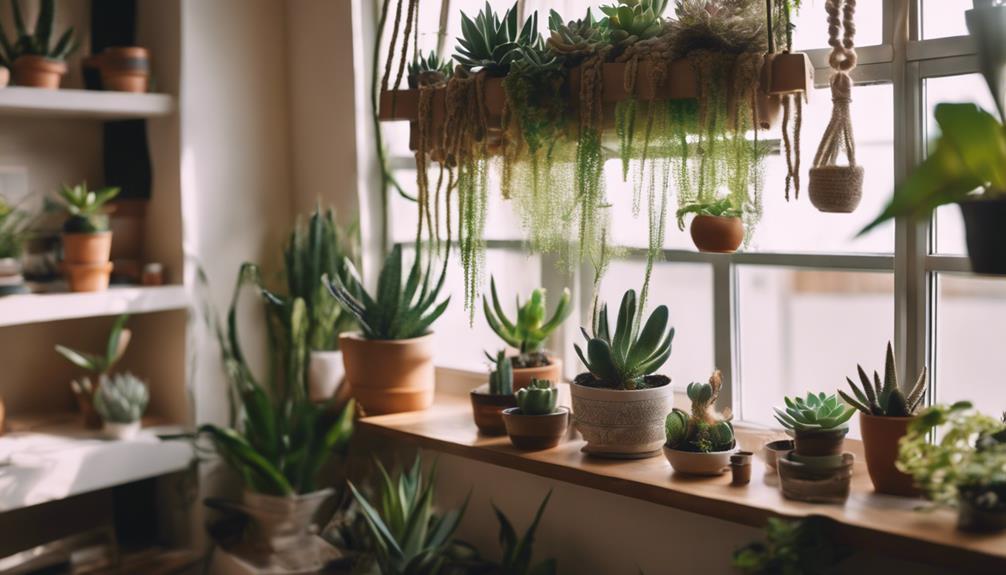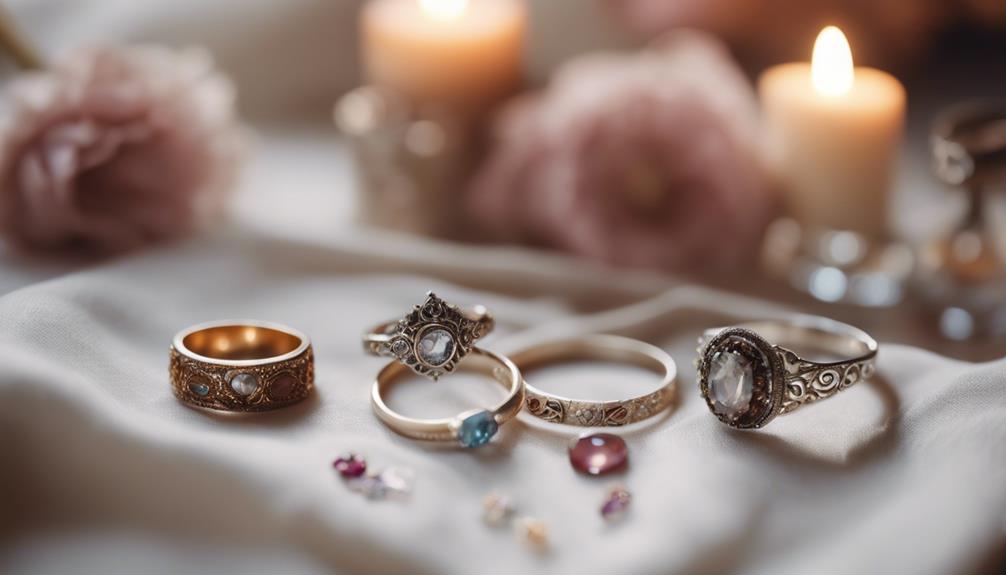Having indoor plants is a great way to liven up your living space and boost your mood. To add some visual appeal, try grouping plants of different heights together. You could also consider creating a plant wall or using macramé hangers to add a stylish touch to your home. Don’t forget to pick out decorative pots that complement your home’s décor. For low-maintenance plants, opt for sturdy varieties like snake plants or pothos. You can even place plants in unexpected locations, such as the bathroom, to add a pop of greenery where you least expect it. If you’re feeling bold, you can experiment with different plant arrangements and create your own indoor garden paradise. Think of it as a plant version of the ultimate hair product showdown! With a bit of creativity and care, your indoor plants can really become the focal point of your home, bringing a sense of peace and tranquility to your living space. So don’t hesitate, unleash your green thumb and elevate your indoor plant game to a whole new level!
Key Takeaways
- Group plants of varying heights and sizes to create dynamic and visually appealing displays throughout your home.
- Use decorative pots and macrame hangers that complement your interior design style for added interest.
- Create a plant wall or cluster plants on surfaces to serve as unique focal points in any room.
- Incorporate low-maintenance plants like snake plants and pothos for effortless greenery that enhances air quality.
Health Benefits of Indoor Plants
Indoor plants aren't just lovely to look at; they can also boost your mood and improve your overall well-being. Studies show that having greenery around can considerably reduce stress and lower cortisol levels, enhancing your emotional state. When you bring plants into your space, you're not just adding beauty; you're also improving air quality. Plants increase oxygen levels and filter out common toxins, creating a healthier indoor environment.
Moreover, indoor plants can raise humidity levels, which aids your respiratory health. They can help alleviate symptoms of dry skin, sore throats, and even the common cold. Engaging in plant care also has its own psychological benefits. Taking time to nurture your plants can promote feelings of happiness and accomplishment, leading to greater life satisfaction.
If you're looking to boost productivity and creativity, consider incorporating plants into your workspace. They can make your environment more conducive to focus and innovation.
Creative Ways to Incorporate Plants
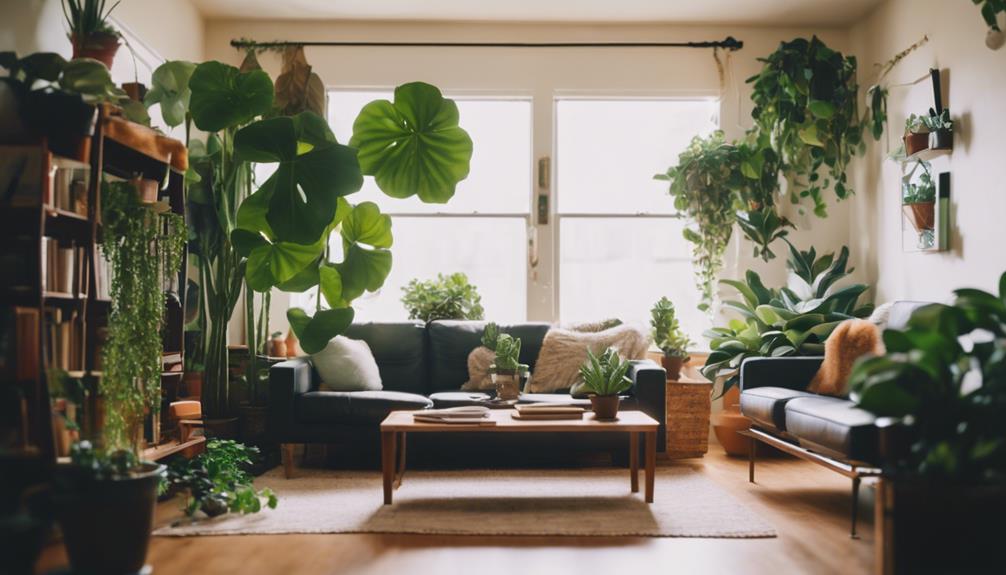
Transforming your space with plants can be as simple as grouping faux and live varieties together to create a stunning display that catches the eye. By experimenting with different heights and sizes, you'll add dynamic visual interest to your home decor. Consider creating a plant wall; it serves as a unique art feature that maximizes vertical space and transforms a blank wall into a focal point.
Using terrariums is another creative approach, allowing you to showcase a contained garden that doubles as a conversation starter. Don't forget the importance of decorative pots and macrame holders—these can match your interior design style and add a personalized touch that integrates your plants seamlessly into your decor.
Here's a quick reference table for inspiration on incorporating plants:
| Plant Type | Creative Idea |
|---|---|
| Faux & Live | Group together for texture contrast |
| Vertical Displays | Create a plant wall |
| Terrariums | Use as a decorative centerpiece |
| Decorative Pots | Match with your decor style |
| Macrame Holders | Hang plants for added interest |
Incorporate these ideas to make your indoor plants integral to your home's aesthetic!
Decor Ideas and Placement Strategies
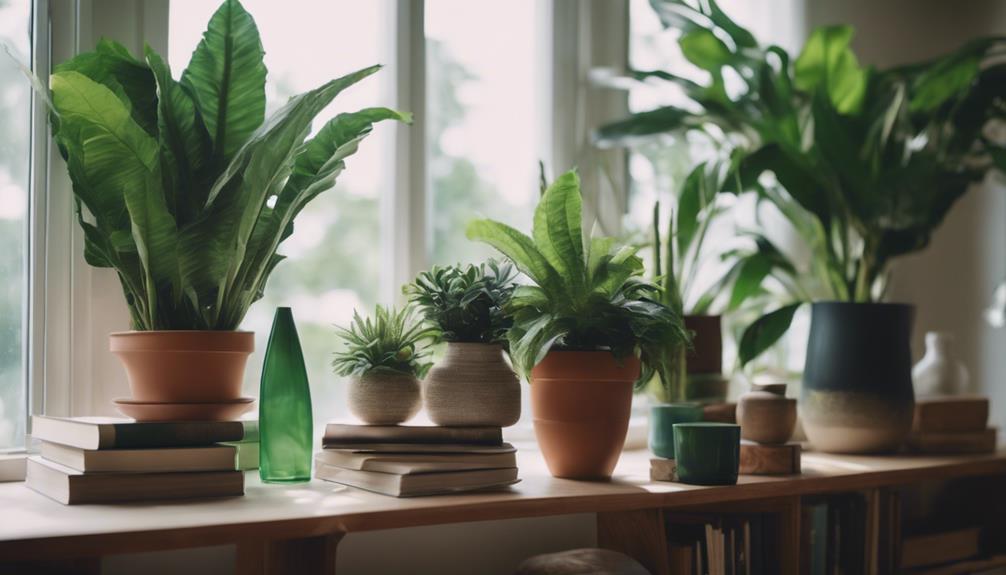
When it comes to decorating with plants, strategic placement can make all the difference.
Think about how grouping plants of different heights on shelves or tabletops can create visual interest while optimizing your space.
You'll also want to contemplate where to position your plants for the best sunlight exposure to keep them thriving.
Strategic Plant Placement Tips
Strategically placing plants throughout your space not only enhances the decor but also creates a harmonious balance that can elevate your home's overall aesthetic. Start by positioning tall plants, like snake plants, in corners to establish a visual anchor. This strategic placement helps balance odd spaces without overwhelming the room.
Incorporate plants into your bathroom to boost the spa-like ambiance and improve humidity levels, benefiting your respiratory health. Use decorative plant stands to elevate smaller plants on tabletops or shelves; this adds height variation and texture to your decor.
When creating a focal point, cluster plants of varying sizes and heights on surfaces like coffee tables and buffets. This arrangement draws the eye and creates a dynamic and inviting display.
Don't forget to place plants near windows for ideal sunlight exposure. Not only does this support their growth, but it also softens harsh edges and shifts in your design. With these strategic placement tips, you'll effortlessly enhance your home's decor and create a welcoming atmosphere that feels fresh and alive.
Creative Grouping Techniques
Grouping plants creatively can greatly enhance your indoor decor, adding both visual interest and inviting energy to your space. Start by clustering house plants of varying heights and sizes. This dynamic aesthetic not only livens up your area but also makes it more inviting.
Consider mixing faux and live plants together; this adds texture contrast and gives you a maintenance-free option when needed. Utilize plant stands or decorative trays to elevate smaller plants, creating layers in your arrangement and drawing the eye upward for a polished look.
When grouping, arrange your plants in odd numbers, like threes or fives, to achieve a natural balance that's pleasing to the eye. Don't forget to experiment with different materials for your planters, such as ceramic, metal, or woven baskets. This can complement your home decor style while adding depth and character to your plant display.
Care Tips for Healthy Plants
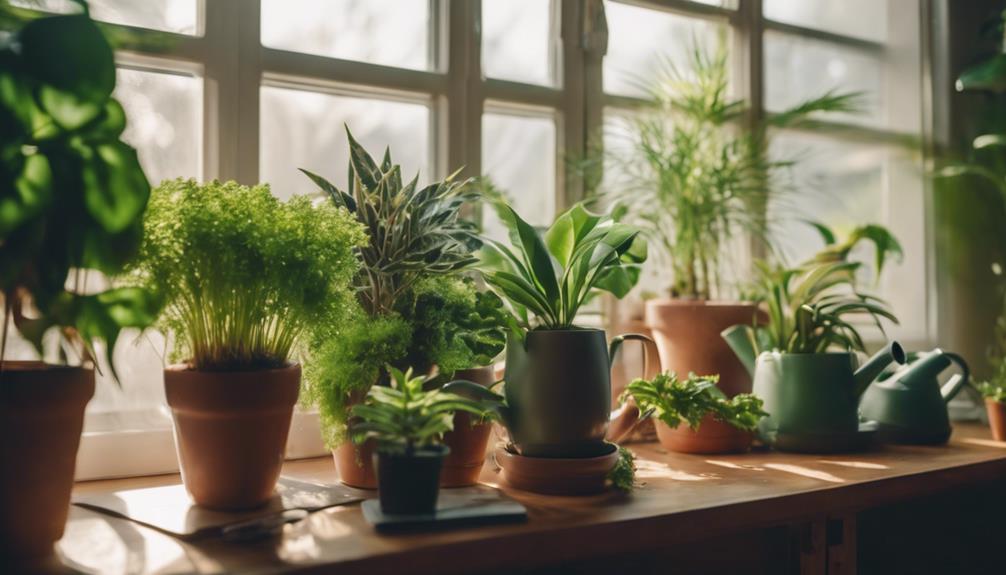
To keep your indoor plants thriving, you need to master ideal watering practices and choose nutrient-rich soil.
Make sure you understand each plant's specific water needs to avoid overwatering, and always use well-draining soil to promote healthy roots.
Optimal Watering Practices
Proper watering is essential for maintaining healthy indoor plants, guaranteeing you provide moisture when the top inch of soil feels dry.
To implement ideal watering practices, always check the soil before watering. This prevents overwatering, which can lead to root rot. When you do water, drench the soil thoroughly, allowing excess water to drain from the pot's bottom. This guarantees that roots receive adequate moisture while preventing nutrient buildup.
If you're looking for plants that are hard to kill, consider adding varieties like snake plants or pothos, as they're forgiving when it comes to watering.
Keep an eye on your plants' specific needs, adjusting your watering routine based on seasonal changes and humidity levels. During the growing season, you might want to water more frequently, while in the winter, you can cut back.
Nutrient-Rich Soil Choices
Choosing the right nutrient-rich soil is crucial for keeping your indoor plants thriving and vibrant. Start by selecting well-draining soil, which prevents root rot and promotes healthy growth by ensuring adequate oxygen circulation to the roots.
If you want to provide your plants with the best foundation, consider using organic soil mixes. These mixes often contain fundamental nutrients and beneficial microorganisms that enhance plant health while reducing the need for chemical fertilizers.
To further improve drainage and aeration, you can incorporate perlite or vermiculite into your potting soil. This makes it easier for roots to access moisture and nutrients, supporting robust growth.
Remember that different plants have unique soil requirements. For instance, cactus and succulent mixes are perfect for desert plants, while moisture-retaining soils work best for tropical varieties.
Additionally, regularly replenishing soil nutrients with organic plant food during the growing season will support vigorous plant growth and overall liveliness.
Top Indoor Plants for Your Home
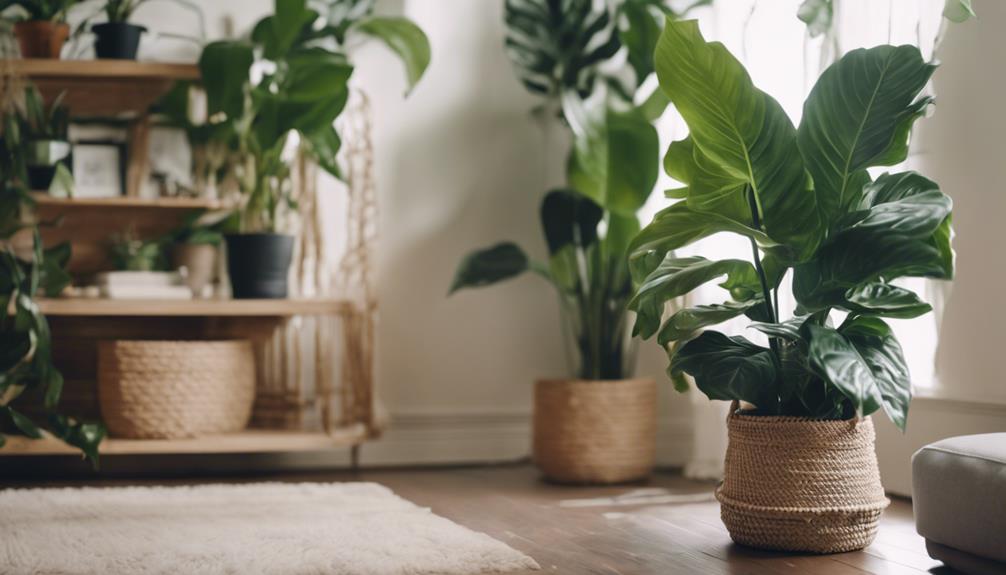
When it comes to enhancing your home's atmosphere, selecting the right indoor plants can transform your space while improving air quality.
One of the best choices for your living room is the Snake Plant. This hardy, low-maintenance plant thrives in low light and serves as a fantastic air purifier, filtering out toxins while adding a touch of green to your decor.
Another excellent option is Aloe Vera. Not only is it easy to care for, but it also purifies the air effectively. Its unique appearance makes it a stylish addition to any room.
The Spider Plant is another favorite, known for its ability to adapt to various conditions and its pollutant-filtering capabilities. Plus, it produces cute 'pups' you can propagate.
If you're looking for something visually stunning, consider the Peace Lily. Its beautiful blooms are sure to catch the eye while it cleans the air around you.
Finally, Golden Pothos offers versatility with its cascading growth, making it perfect for hanging baskets or shelves.
Each of these plants will elevate your home's ambiance and contribute to a healthier environment.
Budget-Friendly Decorating Tips
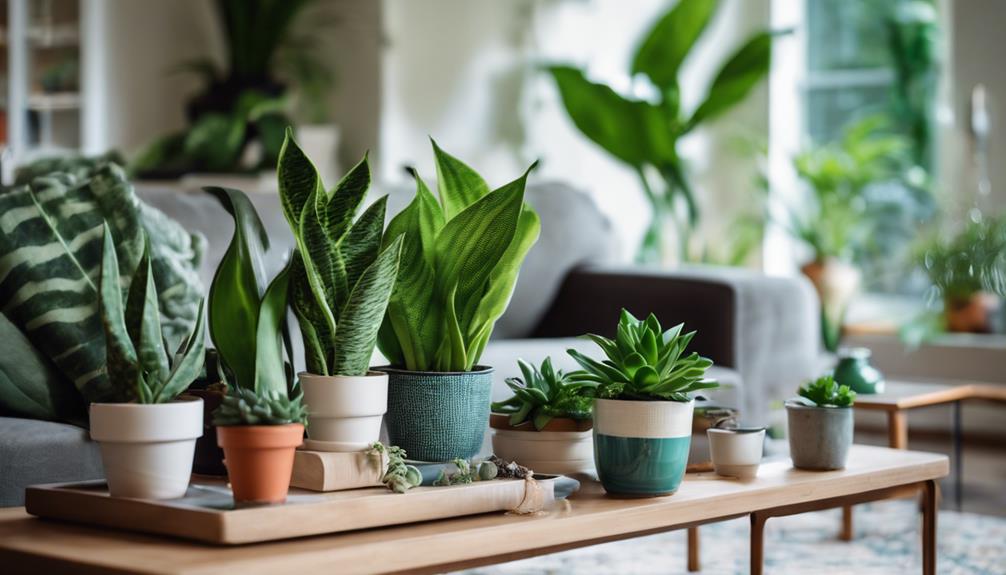
Finding budget-friendly decorating tips can make a big difference in how your indoor plants enhance your space without stretching your wallet. You don't need to spend a fortune to create a stylish atmosphere. Here are three ideas to get you started:
- Functional Decor: Use affordable decorative items like baskets and watering cans as part of your decor. They're practical and can add a rustic charm to your space.
- Unique Planters: Explore local shops or retailers like Target and Home Goods for unique planters that reflect your personal style. These can be found at prices typically between $30 to $60.
- DIY Projects: Try playing around with DIY plant stands or repurposing items like cake stands. This not only saves money but also adds a unique touch to your arrangements.
Don't forget to regularly change out your plants seasonally. This simple trick refreshes your decor without any additional costs.
Frequently Asked Questions
How to Style Your Houseplants?
To style your houseplants, group varying heights together for visual interest, position them near light sources, and use decorative pots. Create dynamic displays with shelves, terrariums, or even a stunning plant wall for added depth.
Do Plants Make Your House Look Better?
Imagine a barren landscape where color fades. Adding plants transforms that desolation into a vibrant oasis. Yes, plants elevate your home's beauty, breathing life into spaces, inviting warmth, and nurturing a calming ambiance you'll adore.
How Do You Rejuvenate Indoor Plants?
To rejuvenate indoor plants, assess their light needs and relocate them if necessary. Prune dead leaves, refresh the soil every couple of years, fertilize during the growing season, and monitor your watering habits closely.
How to Decorate Your House With Houseplants?
To decorate your house with houseplants, group different varieties at varying heights, use stylish pots, and position them near windows. Incorporate them in various rooms for a fresh, inviting atmosphere that enhances your decor.
Conclusion
So, there you have it: transforming your home with indoor plants can be as simple as adding a few greens here and there.
Ironically, while you're busy creating a serene oasis, those plants are silently working to improve your air quality and mood—talk about a win-win!
Who knew your quest for style would also boost your well-being?
Now, go ahead and indulge in some plant therapy; your home—and your mind—will thank you for it!
